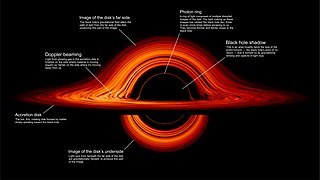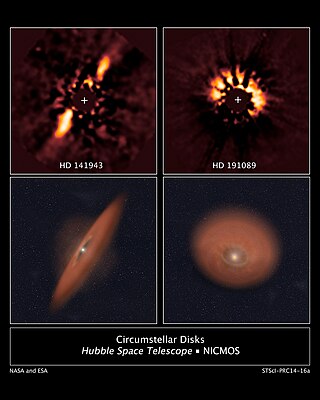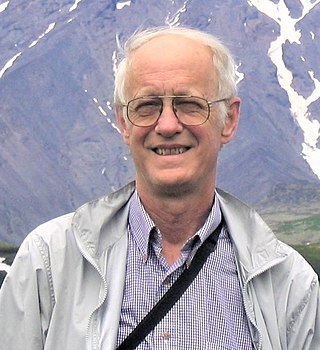
The nebular hypothesis is the most widely accepted model in the field of cosmogony to explain the formation and evolution of the Solar System. It suggests the Solar System is formed from gas and dust orbiting the Sun which clumped up together to form the planets. The theory was developed by Immanuel Kant and published in his Universal Natural History and Theory of the Heavens (1755) and then modified in 1796 by Pierre Laplace. Originally applied to the Solar System, the process of planetary system formation is now thought to be at work throughout the universe. The widely accepted modern variant of the nebular theory is the solar nebular disk model (SNDM) or solar nebular model. It offered explanations for a variety of properties of the Solar System, including the nearly circular and coplanar orbits of the planets, and their motion in the same direction as the Sun's rotation. Some elements of the original nebular theory are echoed in modern theories of planetary formation, but most elements have been superseded.

A protoplanetary disk is a rotating circumstellar disc of dense gas and dust surrounding a young newly formed star, a T Tauri star, or Herbig Ae/Be star. The protoplanetary disk may also be considered an accretion disk for the star itself, because gases or other material may be falling from the inner edge of the disk onto the surface of the star. This process should not be confused with the accretion process thought to build up the planets themselves. Externally illuminated photo-evaporating protoplanetary disks are called proplyds.

In stellar evolution, an FU Orionis star is a pre–main-sequence star which displays an extreme change in magnitude and spectral type. One example is the star V1057 Cyg, which became 6 magnitudes brighter and went from spectral type dKe to F-type supergiant during 1969-1970. These stars are named after their type-star, FU Orionis.

Donald Lynden-Bell CBE FRS was a British theoretical astrophysicist. He was the first to determine that galaxies contain supermassive black holes at their centres, and that such black holes power quasars. Lynden-Bell was President of the Royal Astronomical Society (1985–1987) and received numerous awards for his work, including the inaugural Kavli Prize for Astrophysics. He worked at the University of Cambridge for his entire career, where he was the first director of its Institute of Astronomy.

Planetary migration occurs when a planet or other body in orbit around a star interacts with a disk of gas or planetesimals, resulting in the alteration of its orbital parameters, especially its semi-major axis. Planetary migration is the most likely explanation for hot Jupiters. The generally accepted theory of planet formation from a protoplanetary disk predicts that such planets cannot form so close to their stars, as there is insufficient mass at such small radii and the temperature is too high to allow the formation of rocky or icy planetesimals.

In astrophysics, accretion is the accumulation of particles into a massive object by gravitationally attracting more matter, typically gaseous matter, in an accretion disk. Most astronomical objects, such as galaxies, stars, and planets, are formed by accretion processes.
The magnetorotational instability (MRI) is a fluid instability that causes an accretion disk orbiting a massive central object to become turbulent. It arises when the angular velocity of a conducting fluid in a magnetic field decreases as the distance from the rotation center increases. It is also known as the Velikhov–Chandrasekhar instability or Balbus–Hawley instability in the literature, not to be confused with the electrothermal Velikhov instability. The MRI is of particular relevance in astrophysics where it is an important part of the dynamics in accretion disks.
The Papaloizou-Pringle Instability (PPI) is a scientific discovery made in 1984 by theoretical physicist John Papaloizou and James E. Pringle which proposes that tori, or accretion disks, in anisotropic stellar systems with constant specific angular momentum are unstable to non-axisymmetric global modes.
James Edward Pringle is a British astrophysicist. He is a professor of theoretical astronomy at the Institute of Astronomy, Cambridge part of the University of Cambridge.

Alexey Maksimovich Fridman was a Soviet physicist specializing in astrophysics, physics of gravitating systems and plasma physics. He discovered new types of instabilities in gravitating media, created the theory of planetary rings and predicted the existence of small Uranus satellites that were later discovered. He also developed the hydrodynamic theory of spiral structure in galaxies. Fridman worked at the Institute of Astronomy of the Russian Academy of Sciences, INASAN, and was professor at the Moscow Institute of Physics and Technology and at Moscow State University.
John F. Hawley was an American astrophysicist and a professor of astronomy at the University of Virginia. In 2013, he shared the Shaw Prize for Astronomy with Steven Balbus.

Steven Andrew Balbus is an American-born astrophysicist who is the Savilian Professor of Astronomy at the University of Oxford and a professorial fellow at New College, Oxford. In 2013, he shared the Shaw Prize for Astronomy with John F. Hawley.

Oded Regev is a physicist and astrophysicist, professor emeritus of the Technion, Israel Institute of Technology. He is best known for his theoretical application of fluid dynamics and dynamical systems theory to astrophysics.

Rossby Wave Instability (RWI) is a concept related to astrophysical accretion discs. In non-self-gravitating discs, for example around newly forming stars, the instability can be triggered by an axisymmetric bump, at some radius , in the disc surface mass-density. It gives rise to exponentially growing non-axisymmetric perturbation in the vicinity of consisting of anticyclonic vortices. These vortices are regions of high pressure and consequently act to trap dust particles which in turn can facilitate planetesimal growth in proto-planetary discs. The Rossby vortices in the discs around stars and black holes may cause the observed quasi-periodic modulations of the disc's thermal emission.

An accretion disk is a structure formed by diffuse material in orbital motion around a massive central body. The central body is most frequently a star. Friction, uneven irradiance, magnetohydrodynamic effects, and other forces induce instabilities causing orbiting material in the disk to spiral inward toward the central body. Gravitational and frictional forces compress and raise the temperature of the material, causing the emission of electromagnetic radiation. The frequency range of that radiation depends on the central object's mass. Accretion disks of young stars and protostars radiate in the infrared; those around neutron stars and black holes in the X-ray part of the spectrum. The study of oscillation modes in accretion disks is referred to as diskoseismology.

A circumstellar disc is a torus, pancake or ring-shaped accretion disk of matter composed of gas, dust, planetesimals, asteroids, or collision fragments in orbit around a star. Around the youngest stars, they are the reservoirs of material out of which planets may form. Around mature stars, they indicate that planetesimal formation has taken place, and around white dwarfs, they indicate that planetary material survived the whole of stellar evolution. Such a disc can manifest itself in various ways.
Andrew Robert King, is a British astrophysicist and Professor of Astrophysics in the Department of Physics and Astronomy at the University of Leicester. His previous institutions include University College London and the Institute for Theoretical Physics at the University of Hamburg and a visiting position at the Observatoire de Paris. He currently holds visiting positions at the Astronomical Institute of the University of Amsterdam, and he is a visiting professor at Leiden University. He has served as Editor and now is Deputy Editor-in-Chief of the international astronomy journal Monthly Notices of the Royal Astronomical Society.
Omer Michael Blaes is an American astrophysicist. He is a professor of physics at University of California, Santa Barbara.

Ramesh Narayan is an Indian-American theoretical astrophysicist, currently the Thomas Dudley Cabot Professor of the Natural Sciences in the Department of Astronomy at Harvard University. Full member of the National Academy of Sciences, Ramesh Narayan is widely known for his contributions on the theory of black hole accretion processes. Recently he is involved in the Event Horizon Telescope project, which led in 2019 to the first image of the event horizon of a black hole.

Richard Van Evera Lovelace is an American astrophysicist and plasma physicist. He is best known for the discovery of the period of the pulsar in the Crab Nebula, which helped to prove that pulsars are rotating neutron stars, for developing a magnetic model of astrophysical jets from galaxies, and for developing a model of Rossby waves in accretion disks. He organized a US-Russia collaboration in plasma astrophysics, which focused on modeling of plasma accretion and outflows from magnetized rotating stars.












